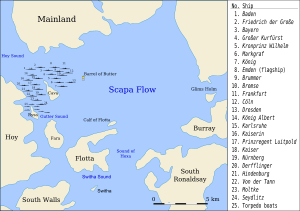Gutter Sound facts for kids
Gutter Sound is a special place in Orkney, Scotland. It's part of a huge natural harbour called Scapa Flow. This area is located west of the main harbour. It sits between the islands of Cava and Fara, and the larger island of Hoy.
In 1919, Gutter Sound was where many ships from the German High Seas Fleet were sunk on purpose. This event is called a "scuttling." Later, in the 1920s, a big effort was made to pull these ships out of the water. This is known as a "salvage operation." Today, the ships that are still underwater make Gutter Sound a very popular spot for divers.
Contents
Where is Gutter Sound Located?
Gutter Sound is a stretch of water about four miles (6.4 km) long. At its widest, it is about one mile (1.6 km) across. In some spots, the water is around 30 meters (98 feet) deep.
This sound separates the island of Hoy from Cava in the north. It also separates Hoy from Fara in the south. Gutter Sound opens into Scapa Flow between Cava and Fara. To the north, it connects to an area called the Bring Deeps. To the south, it joins Weddell Sound, which is between Fara and Flotta. It also connects to Switha Sound, found between Flotta and Hoy.
History of Gutter Sound's Shipwrecks
After the First World War ended, the German High Seas Fleet surrendered. These ships were brought to Scapa Flow and anchored around the island of Cava. Some were in Gutter Sound itself, and others were in the water between Cava and a small rocky island called the Barrel of Butter.
In 1919, something amazing happened here. The German sailors decided to sink their own ships on purpose. This was a mass "scuttling" of the fleet. Twelve large warships and many smaller vessels went down in Gutter Sound. The rest sank in deeper water between Cava and the Barrel of Butter.
Salvaging Sunken Ships
During the 1920s, a man named Ernest Cox led a huge effort to pull many of these sunken ships out of the water. This process is called salvage. He used different methods to do this. For smaller ships, he used special floating docks and strong ropes to lift them.
For the much larger ships, he had to be very clever. Workers patched up all the holes in the ship's hull (the main body of the ship). Then, they pumped compressed air into the ships. This air pushed the water out, making the ships float upside down! Seven of these shipwrecks are still in Scapa Flow today. They are protected as important historic sites underwater.
Gutter Sound in World War II
During the Second World War, Gutter Sound was again used by the Royal Navy. It was home to HMS Proserpine, which was a land base at Lyness. It also served as a base for anti-submarine patrol forces and their support ship, HMS Dunluce Castle.
Commercial salvage work on the wrecks stopped in the late 1970s. Today, it's no longer possible to salvage more ships from this area.
Lyness is now home to a Naval Cemetery, where sailors are buried. There's also a Heritage Centre that tells the story of these events. It's also a Dive Centre, because the seven ships that remain are a very popular place for divers to explore.
Diving the Wrecks in Gutter Sound
Today, the seven remaining shipwrecks are quite deep. However, they offer exciting and popular dives for experienced scuba divers. Divers also explore other pieces of wreckage and debris left over from the ships that were salvaged.
| Name | Type | Depth |
|---|---|---|
| SMS Brummer | light cruiser | 36 m (118 ft) |
| SMS Cöln | light cruiser | 36 m (118 ft) |
| SMS Karlsruhe | light cruiser | 36 m (118 ft) |
| SMS Dresden | light cruiser | 25 m (82 ft) |
| SMS König | battleship | 43 m (141 ft) |
| SMS Kronprinz Wilhelm | battleship | 38 m (125 ft) |
| SMS Markgraf | battleship | 47 m (154 ft) |


